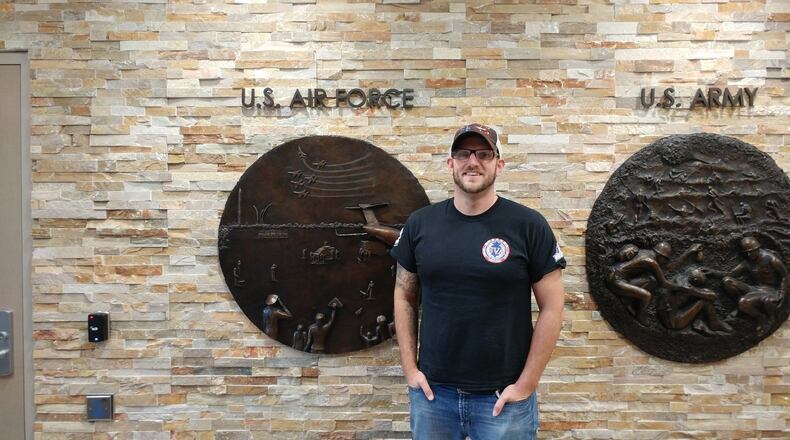“It was quite difficult because there’s no real way to transition from loading munitions on an aircraft to anything else in the civilian world,” he said. “Nobody is looking to hire somebody loading munitions on an aircraft so I pretty much had to start from my high school diploma.”
Morse completed a Transition Assistance Program in the military before he added the title of veteran when he left the Air Force.
The program is supposed to help him and other departing service members make the transition to civilian life more informed about their benefits and better able to find a job after life in uniform. But Morse said he left confused after a dizzying array of information.
‘A lot of information’
“It was a lot of information at once,” said Morse, 35, of Dayton. “It was overwhelming.
“When it’s information overload you just kind of come out of there discombobulated,” he said. “You don’t know where to start. My main focus was I just need a job.”
The U.S. Government Accountability Office surveyed 181 military installations where the program is offered, including Wright-Patterson Air Force Base, and found the program needs improvement.
The GAO found in reviewing performance data for fiscal year 2016 that the Department of Defense needs to improve how soon departing service members complete the program. More than half, or 53.3 percent, finished the program with less than 90 days to the date of separation, missing the regulatory deadline of a minimum of 90 days before a service member leaves the ranks.
Wright-Patterson had statistics similar to the national findings, said Cindy S. Barnes, a GAO researcher who compiled the report, which was publicly released this week.
Since January 2014, more than 4,200 service members have gone through the program at Wright Patt, base figures show.
Deidra Bartlett, a 47-year-old Air Force veteran from Huber Heights, completed the TAP program at Wright-Patterson before she left the military in the late 1990s.
The former military personnel specialist found what she learned was “very helpful and very insightful” to write resumes, engage in mock job interviews and translate what she did in the military into civilian workforce parlance. The GAO report found most service members reported TAP was a positive experience.
“What I found when I was applying for positions was that there were a lot of employers interested in hiring veterans,” said Bartlett, human relations director at Charter Communications in Dayton and Columbus. “It wasn’t a difficult transition when I found out what they were looking for.”
Teamwork, leadership and technical skills are some of the things that stand out about former service members to employers, she said.
Finding a place
But for some veterans, finding a place in society after the military can be daunting, as it was for Morse.
After leaving Hill Air Force Base in Utah, he started as a used car salesman for a few weeks before moving to other jobs. Eventually, he returned to family in Ohio and enrolled in the social work program at Wright State University where after graduation he plans to find a job helping veterans.
“We have a culture in the military and when we try to go back into society it’s not the same,” he said. “The reason I bounced from job to job to job was because I didn’t feel like I fit into society.”
Seth Gordon, director of the Wright State University’s Veteran and Military Center, said Department of Defense transition programs are often squeezed in at the end of a person’s military career with overwhelming amounts of information.
“Then when they actually need to come to school for instance, or do something else, they’re frustrated because they don’t remember anything,” he said. “…The DoD is trying, but they’re doing it in a way that is not actually working.”
False stereotypes about veterans, such as a stigma about post-traumatic stress for those who have been in combat, are part of the problem when they look for employment, he said.
Civilian employers should consider the leadership roles and skills many former service members have despite the fact some prior enlisted personnel who may not have a college degree, he added.
“Companies should say bachelor’s degree or military experience required because for many things these people are already functioning in the military world in environments where in the civilian world you would need a bachelor’s degree just to apply,” Gordon said. “Then you’re making them jump through hoops and you’re missing out on good talent.”
Gordon added he has heard many young veterans express high frustration about getting needs met through the U.S. Department of Veteran Affairs.
The VA is the largest provider of veterans’ services nationwide. The Dayton VA alone, with a main campus and four outpatient clinics, serves more than 40,000 veterans a year in the region.
Even so, getting the word out that services are available to many after they leave the military is daunting, too.
Michael Schneider, a Dayton VA Medical Center community outreach specialist, travels to public events to spread the word on VA services, from home loans or housing stipends to receiving health care.
Schneider said he’s “a little bit surprised” many veterans are unaware they qualify for benefits.
“I think it gets to you don’t know what you don’t know thing,” he said.
Beginning next year, the Dayton VA plans to have quarterly open house-style events veterans can attend to learn about the services available to them, said spokesman Ted Froats.
“There is a vast area of things that veterans may need,” said Rhonda Allen-Garry, a Dayton VA supervisory social worker for ambulatory care programs.
About the Author
